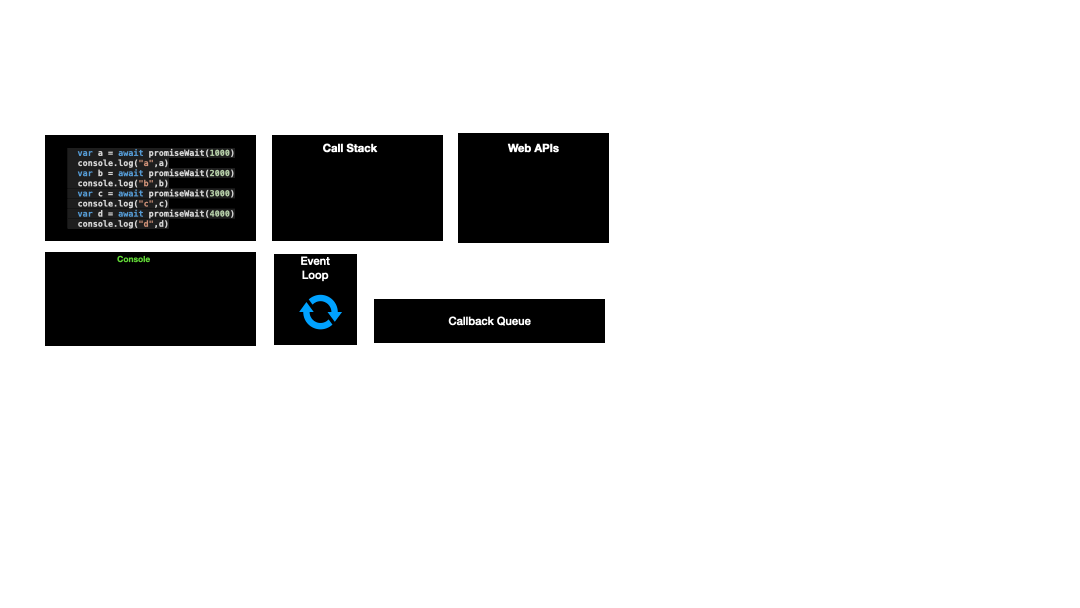What makes `async/await` statements run sequentially vs in parallel in ES6?
I this case all 4 promises started at the same time. Therefore its setTimeout timer runs parallel in the background.
The timers have an difference with 1 second so if you put an console log between the awaits you should see around every second a new console log.
function promiseWait(time) {
return new Promise((resolve, reject) => {
setTimeout(() => {
resolve(true);
}, time);
});
}
async function test2() {
var t0 = performance.now()
console.log("putting promises in que");
const p1 = promiseWait(1000);
const p2 = promiseWait(2000);
const p3 = promiseWait(3000);
const p4 = promiseWait(4000);
console.log("promises where added to the que");
const a = await p1;
console.log("1")
const b = await p2;
console.log("2")
const c = await p3;
console.log("3")
const d = await p4;
console.log("4")
var t1 = performance.now()
console.log("Call to doSomething took " + (t1 - t0) + " milliseconds.")
}
test2()Visualized it looks something like this:
setTimeout(() => {
let divs = document.querySelectorAll("div").forEach(div => {
div.style.setProperty("width", "100%")
})
},500)div {
height: 30px;
background: red;
margin: 10px;
width: 0px;
transition: width 4s;
color: white
}<div style="max-width: 100px";>
Promise 1
</div>
<div style="max-width: 200px";>
Promise 2
</div>
<div style="max-width: 300px";>
Promise 3
</div>
<div style="max-width: 400px";>
Promise 4
</div>Case 1 visualized:
let divs = document.querySelectorAll("div")
let delay = (time) => new Promise(res => setTimeout(res, time));
(async() => {
for(let i = 0; i < divs.length; i++) {
await delay(i + 1000);
divs[i].style.setProperty("width", "100%");
}
})()div {
height: 30px;
background: red;
margin: 10px;
width: 0px;
transition: width 4s;
color: white
}<div style="max-width: 100px";>
Promise 1
</div>
<div style="max-width: 200px";>
Promise 2
</div>
<div style="max-width: 300px";>
Promise 3
</div>
<div style="max-width: 400px";>
Promise 4
</div>With some more deep dive ... (Inspired by Philip Roberts).
Case 1: SetTimeout triggers one by one
function promiseWait(time) {
return new Promise((resolve, reject) => {
setTimeout(() => {
resolve(new Date().toISOString().split('.')[0].replace('T',' '));
}, time);
});
}
async function test1() {
let timeStamp = new Date();
var t0 = new Date();
console.log("t0",t0)
var a = await promiseWait(1000)
console.log("a",a)
var b = await promiseWait(2000)
console.log("b",b)
var c = await promiseWait(3000)
console.log("c",c)
var d = await promiseWait(4000)
console.log("d",d)
var t1 = new Date();
console.log("t1",t1)
console.log("Call to doSomething took " + (t1 - t0) + " milliseconds."); //takes 10secs
}
test1()
Console: You can notice that sum of each timeout is resulted ~10 Secs.

Case 2: SetTimeout triggers at same time.
function promiseWait(time) {
return new Promise((resolve, reject) => {
setTimeout(() => {
resolve(new Date().toISOString().split('.')[0].replace('T',' '));
}, time);
});
}
async function test1() {
let timeStamp = new Date();
var t0 = new Date();
console.log("t0",t0)
const p1 = promiseWait(1000);
const p2 = promiseWait(2000);
const p3 = promiseWait(3000);
const p4 = promiseWait(4000);
console.log("p1",p1);
console.log("p2",p2);
console.log("p3",p3);
console.log("p4",p4);
const a = await p1;
console.log("a",a);
const b = await p2;
console.log("b",b);
const c = await p3;
console.log("c",c);
const d = await p4;
console.log("d",d);
var t1 = new Date();
console.log("t1",t1)
console.log("Call to doSomething took " + (t1 - t0) + " milliseconds."); //takes 10secs
}
test1()
Console: Here we can notice that timer started together so it resulted with ~ 4 Secs. (Last timer is set at 4 sec).

In the first case because of the await before each call to the promiseWait, to even start executing the next call to the promiseWait it needs to wait until the first call to the promiseWait is finished completely. So you see sequential execution.
In the second case you have already invoked all the promiseWait functions before you start awaiting them. So the promiseWait has already started executing, then you are awaiting the results one after another.
Implementation wise in the first scenario, the next call to the setTimeout has to wait until the first setTimeout expires. So the second, third and the fourth timers need to wait until the first timer expires and resolves the promise in order to be scheduled.
In the seconds case you schedule the setTimeout calls one after the other, so the timers are all already queued. Then you are just awaiting for the timers to expire and resolve your promise one by one.